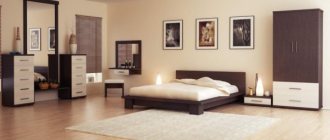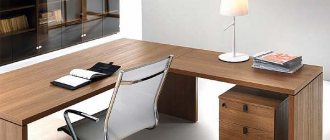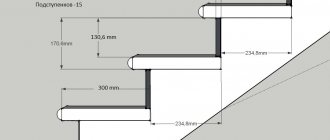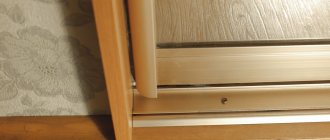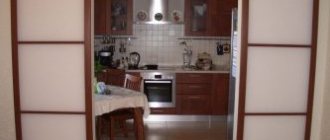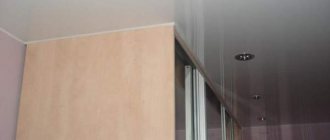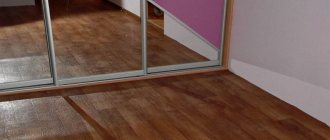For most residential premises, the choice of interior doors does not present any problems; one can proceed solely from aesthetic preferences.
The bathroom is a room with specific operational loads, as a result of which special requirements are imposed on all elements of decoration, furniture and even interior doors.
First of all, this is due to the fact that there is always high air humidity in the bathroom and toilet, even with a high-quality ventilation system. In this regard, it is necessary to choose doors for the bathroom and toilet that can withstand moisture and steam for a long time without deformation, maintaining the original appearance and functionality. For example, sliding doors are unlikely to work.
The second important point is the increased requirements for noise and heat insulation of the door structure.
Choosing doors to the bathroom
Bathroom and toilet door material
The first criterion by which a consumer usually chooses interior doors is the material from which they are made. This largely determines the cost of the product.
Due to the fact that modern processing technologies are used in the manufacture of door leaves and frames, there are no absolute technical contraindications to installing doors made of any material, however, practicality and durability may vary. Therefore, before choosing doors to the bathroom and toilet, it is worth learning more about the advantages and disadvantages of products made from various materials.
Glass doors
From the point of view of moisture resistance, glass is the best option. It is not at risk of deformation from steam, destruction under the influence of water, high temperature or temperature changes.
Moreover, glass is an environmentally friendly material, it is hygienic, has good sound insulation and high thermal insulation properties.
Glass door panels for toilets and bathrooms are absolutely safe; they are made from high-strength tempered glass, so there is no fear of injury - it is almost impossible to accidentally break them at home.
Installing glass doors in the bathroom
The canvases can have different coatings - tinting with varying degrees of transparency, matte coating, relief pattern and even a mirror surface. Inserts made of wood, plastic, metal, mosaics, luxurious sandblasted patterns and designs are used as decor. All this should be consistent in a single bathroom design.
Glass models are original and sophisticated; they bring lightness and elegance to the interior. Thanks to their brevity and apparent weightlessness, the size of the space visually increases.
An additional advantage for bathrooms, which are usually not equipped with windows, is the fact that glass models, even with a frosted coating, retain more natural light than traditional blind panels.
Thanks to excellent consumer characteristics, ease of maintenance, the presence of all the properties necessary for bathrooms and a stylish appearance, glass doors are in great demand. The only drawback of such products is the rather high price.
Plastic doors
Plastic is great for wet areas. Doors made of this material do not rot or deform under the influence of hot steam and water.
In addition, they are hygienic, durable, practical and lightweight. Their sound and thermal insulation performance is at a decent level. These door structures are easy to clean, they are resistant to aggressive household chemicals and retain their original appearance for a long time.
With the help of special coatings, the surface of plastic door structures can imitate almost any material; their color palette is very wide.
Of course, in terms of aesthetics, PVC doors are significantly inferior to their exquisite glass and luxurious wooden counterparts, but their low cost, practicality and durability have made them a very popular option among most consumers.
For a bathroom with a budget affordable renovation, this is an ideal option.
Wooden doors
The material is very susceptible to the negative effects of moisture, and especially hot steam, and can quickly deform and become unusable if constantly exposed to a humid, warm environment.
At the same time, installing wooden doors in bathrooms is a classic option and cannot be called completely unreasonable. But you need to find out all the nuances and weigh the pros and cons of such a decision before choosing doors for the bathroom and toilet made of wood.
The main question of the feasibility of such a choice is the interior in which the doors will be installed, and the amount that is expected to be spent on them.
If there is no special design need for natural wood and the renovation budget is limited, you should refrain from using wooden door designs.
The fact is that the most resistant types of wood (usually beech or oak) and high-quality processing, which allows maximum protection of the material from harmful effects, are quite expensive; accordingly, such doors cannot cost the same as ordinary interior doors made of pine.
Installing wooden doors in the bathroom is an unusual solution
And if you buy a wooden product in the middle price range, there is a high probability that over time the door leaf will deform and shift, and the door will no longer close tightly.
Partially, the problem of wood's susceptibility to moisture is solved by coating it with special varnishes, but they need to be updated in a timely manner; in addition, caring for a wooden surface is complicated by the fact that dust and dirt eat into the pores of the wood and it is problematic to wash them.
There is an opinion that if the ventilation system works well, the steam will not harm the doors. This statement is true exclusively for spacious bathrooms, and in the vast majority of typical apartments they are so small that the hood simply does not have time to pick up all the steam before it hits the door leaf; in addition, water splashes mixed with soap will inevitably fall on it. Therefore, even with good operation of the hood and excellent ventilation, a wooden door should be chosen only by those who are ready to periodically carry out cosmetic repairs - cleaning, opening with a new layer of varnish, etc.
At the same time, in an expensive, noble interior of a classical style, such doors are irreplaceable. But in this case, a significant budget must be allocated for their acquisition.
In addition, at the design stage you should consider ensuring that the entrance to the bathroom is located as far as possible from sources of water and steam.
Chipboard and MDF
Door structures for bathrooms and toilets made of chipboard and MDF, covered with a special laminate, are in demand among consumers. Such models have proven themselves to be excellent in wet rooms, their designs are varied, and the price is affordable.
There are several nuances to choosing such products. First of all, models covered with veneer are suitable for bathrooms only if the technology of cross-shaped gluing of fibers was used during its application, otherwise natural veneer will not withstand constant contact with warm, humid air.
When choosing models that use laminate as a covering, it is important to pay attention to the fact that it is made of PVC and not paper.
We install doors made of chipboard and MDF: the best option for the bathroom
Specifics of installing doors in the bathroom
In the place where bathroom doors are installed, as a rule, a small threshold with a height of approximately five centimeters is installed; it is provided in case of flooding of the bathtub, so that water does not immediately flow into other rooms.
Because of this, the doors for the toilet and bath are installed higher than the others, and this difference between them is approximately ten centimeters.
Usually, when renovating an apartment, they try to install the same type of doors in all rooms. And often standard two-meter interior doors to the bathroom are chosen, although in a standard bathroom the door opening is never more than 1 meter 90 centimeters in height.
Therefore, to achieve the desired result, either the opening or the door leaf is usually adjusted.
Interior doors to the bathroom
The walls of a typical bathroom are usually four to five centimeters wide, so when choosing doors, you need to select a frame for it based on this calculation.
An ideal box can be wider than the wall by a maximum of 1 cm 50 mm (the glued tiles fit into this space).
Then it will be the same width as the tiled wall of the bathroom or toilet. Otherwise, you will need to increase the thickness of the wall in the bathroom on one side, or remove excess width from the frame.
You need to know that the painting of the sawn surface will be of a different quality than the rest of the box, and it is unlikely that it will be possible to hide the cut line itself, even though it will be covered with a platband.
It is not advisable to cut off the excess width from the veneered box (if you have chosen it), since the remaining part of the veneer will probably delaminate after some time.
Individual boxes are made of coniferous wood, covered with veneered hardboard (MDF), if such a box is sawed off, it can easily crumble.
Because of this, it is better not to experiment with sawing boxes, although if there are gaps between the wall surface and the platbands, they will need to be closed somehow, for example, using a gypsum mixture.
Recommendations for choosing a bathroom door
- When installing doors in a bathroom or toilet adjacent to a kitchen or other living room, the simultaneous placement of two swing doors can interfere with the opening and closing of each other, and also lead to frequent collisions, which can cause chips, scratches and dents on both doors. The optimal solution in this case is to install coupe models in the bathroom.
- The door to the toilet and bathroom must be equipped with a special ventilation hole or have a sufficiently large gap between the door leaf and the floor.
- Handles and locking mechanisms are subject to greater loads than locks and handles of all other interior doors, so increased demands must be placed on them.
Sliding door to bathroom
Recently, sliding doors to the bathroom and bathroom have become very popular. Such doors are distinguished by the fact that they do not open wide, but slide to the side, like wardrobe doors. If you decide to install such doors, they will look very aesthetically pleasing and will complement the interior well. In addition, sliding doors save space and you are less likely to bump into a door in a narrow hallway, as is the case with swing doors when someone leaves the bathroom.
As you can see, the choice of doors for the bathroom is very wide, and you can always choose which doors to install in the bathroom, starting from the general concept of interior design.
In the next publication we will talk about how to install bathroom doors.
See also:
How to install a door in the bathroom?
Sliding doors to the bathroom
What size is the bathroom door?
Glass doors for bathroom
Plastic bathroom door
English style doors
- <How to install a door in the bathroom?
Door design
The basic rule that should be followed when choosing a door to a bathroom or toilet is the same design style as the rest of the interior doors opening onto a common corridor; only the material and finish may differ.
The negative impact of water is manifested not only for the door leaf itself, but also for decorative elements, so they all must be resistant to moisture; from this point of view, complex finishing on the side of the bathroom itself is impractical. At the same time, manufacturers, knowing this nuance, often produce models decorated only on the outside.
Installation Features
The technology for installing doors to the bathroom and toilet has a number of important differences from the installation of conventional interior doors.
- According to safety regulations, the height of the threshold should be about five mm. This will protect living rooms from flooding in the event of a washing machine leak, pipe break, or other plumbing accident.
- Due to the presence of a high threshold, the doors for the bathroom and toilet will have to be installed 10 mm higher in comparison with other interior doors, so the opening may not correspond to a standard two-meter factory door. Either you will need to increase the opening, or order the door according to individual sizes.
Cutting a door yourself is not only not always technically possible (as, for example, in the case of a glass sheet), but it is also extremely undesirable, even if technically it can be done - after cutting, the veneer will begin to peel off over time and the product will lose its original appearance and may be deformed under the influence moisture.
- It is necessary to leave a ventilation gap of 1 cm between the door leaf and the threshold. If you purchased a door specifically designed for the bathroom, a hole has already been made in it for the ventilation grille, and in this case this requirement can be neglected.
- The door frame must be installed before finishing the walls, and the door leaf should be installed after the bathroom renovation is completed.
- If swing doors are installed, they must be installed in such a way that they open outwards. This will allow you to make the most of the entire bathroom space. If the door opens inward, the surrounding space will need to be left empty.
We approach the choice of bathroom fittings responsibly
Design Features
When choosing which door is best to install in the bathroom, many people, out of habit, opt for solid door-type models. This is the most popular solution and is most often associated with habit or lower cost. However, the following types would be appropriate for this room:
- harmonic;
- book;
- coupe – “pencil case” option;
- rotary.
The main thing in the design is to ensure protection of external premises from dampness, high temperature and sound insulation: the sound of water can be very loud and disturb the rest of the household.
What doors are better to choose for a bathroom, besides standard ones? Rotary ones are most similar to the usual hinges, but instead of the usual hinges they have rotor mechanisms that are installed in the floor and upper part of the door frame. For them, it is better to use a thin material, such as tempered glass.
What kind of interior doors are there: their types according to the method of opening
There are doors between interior spaces in almost any home. The exception is designer interiors, where rooms are demarcated in other ways. Let's figure out what types of interior doors there are and their types according to the method of opening.
An accordion and a book would be appropriate in rooms where the doorway is wider than usual - when folded, such doors take up little space for passage. You also need constant care for the guide and hinge systems - without timely cleaning and lubrication, the structure will creak and perform poorly.
Sliding doors are an exotic option that is suitable for spacious bathrooms, as they do not allow for sealing. To better protect external premises from moisture, it is better to use an option where the door goes into a pencil case built into the wall.
A sensitive issue is the use of glass. On the one hand, excess transparency is unacceptable, on the other hand, even by turning on the light it is easier to understand whether there is someone in the room, not to mention the high decorative possibilities. Therefore, in door designs they use either stained glass, frosted glass, or with applied relief.
Choosing doors for the bathroom and toilet
- The design of the doors must match the style of the interior and be combined with the design of other interior doors, even if you are planning a budget bathroom renovation.
- The main criteria when choosing the optimal door material should be durability, practicality, design and price of the product.
- An important point is the choice of opening type; it is necessary to evaluate which model will be more convenient: sliding or hinged.
- Before you start choosing a specific model, you need to measure the opening and wall thickness to find out whether standard size doors will fit or whether they will need to be made to order.
- Once all the requirements for the doors have been established, the material from which they should be made has been selected, all that remains is to find a reliable manufacturer and choose the optimal model.
The choice of doors for the bathroom and their installation is an important stage of renovation. It is necessary to know not only the general features of this type of premises, but also the individual parameters of the room, such as size, ventilation, distance of the entrance from sources of water and steam.
Before buying a bathroom door, we measure the opening.
If you take into account all aspects before choosing doors for the bathroom and toilet, you will be able to choose the ideal product that will last for many years.
In addition, it is necessary to balance the budget with the preferred material, and if you choose between, for example, a cheap wooden option and mid-price chipboard, you should choose chipboard.
What to consider when choosing doors
Traditionally, we choose the material, shape and size of the door for the bathroom and toilet, as for any other interior passages and openings. Usually, the main criterion in selecting a door leaf and hatch is the perception of how well the texture and color of the finish fits the interior of the corridor and, in fact, the bathroom itself.
In addition to beauty and design, you need to consider a couple more important points:
- The material from which the doors to the bathroom and toilet are made;
- Installation method and operation of the door mechanism, ensuring smooth opening and closing;
- Sound and heat insulation of the door leaf;
- High-quality sealing and proper arrangement of ventilation windows.
All of these factors are interconnected, since any of the parts and quality characteristics indirectly affects the operation of the remaining elements and the entire door as a whole. As a rule, a manufacturer of high-quality bathroom and toilet doors combines all important elements into one structure and hides them from prying eyes. Only door handles with a lock and decorative trim remain for users.
Advice! Door handles for bathrooms and toilets work in more difficult conditions than similar devices in other interior doors, so in most cases they are chosen and purchased separately, based on their preferences and the characteristics of the doorway design.
An exception can only be made for special door hanging and opening schemes, where a standard tongue lock and rotary handle cannot be installed for technical reasons. In addition, the locking mechanism and door handle are more often exposed to condensation and detergents. Handles on toilet and bathroom doors are regularly cleaned with disinfectants and detergents, so the best choice would be models with wear-resistant chrome plating or painted anodized aluminum.
